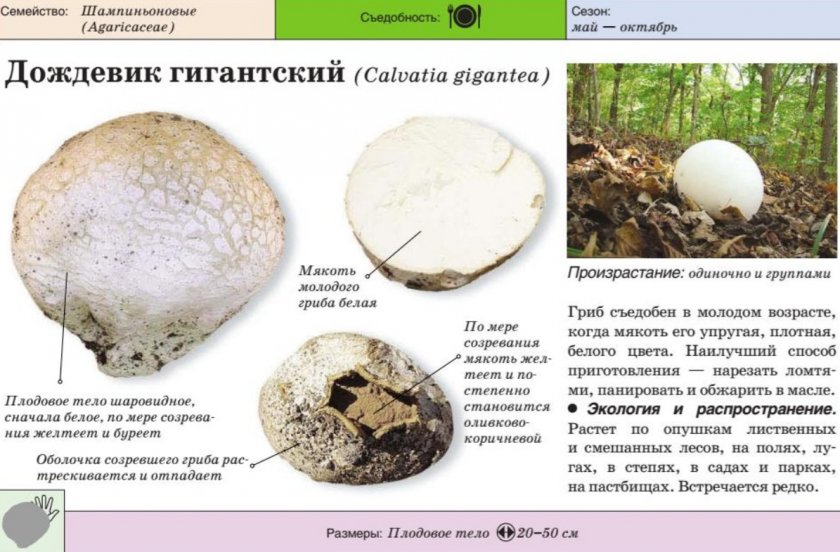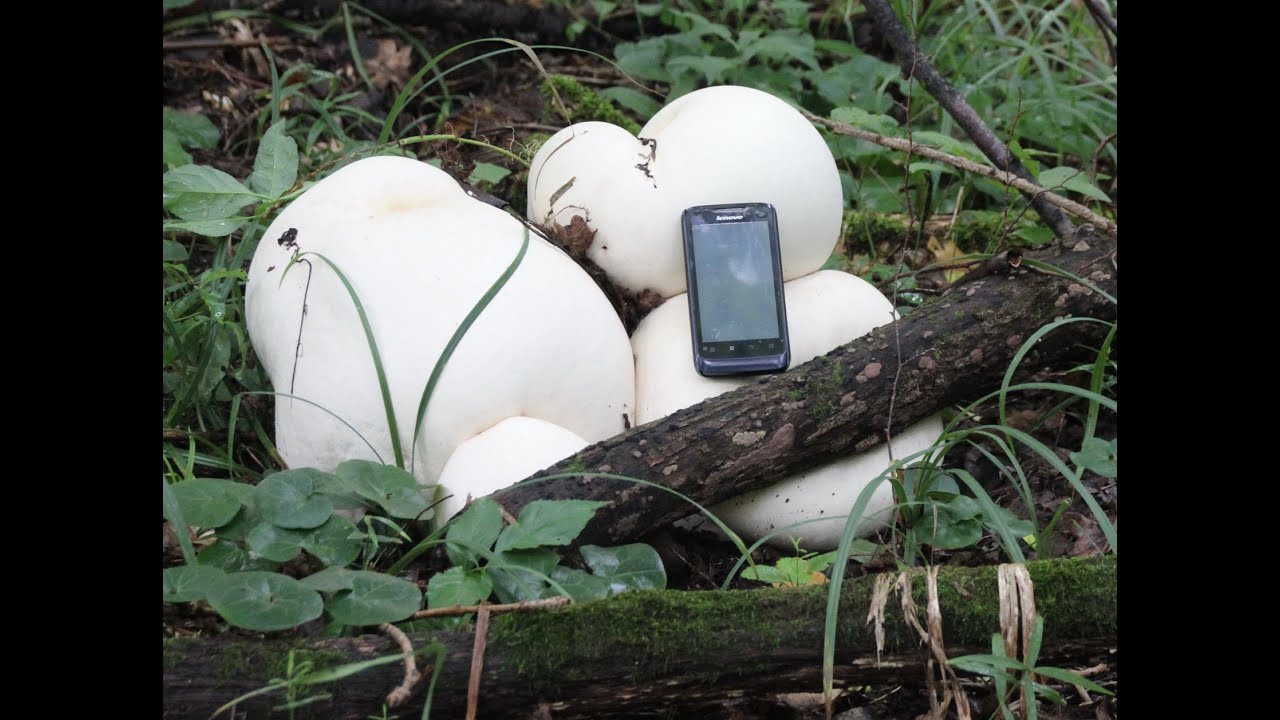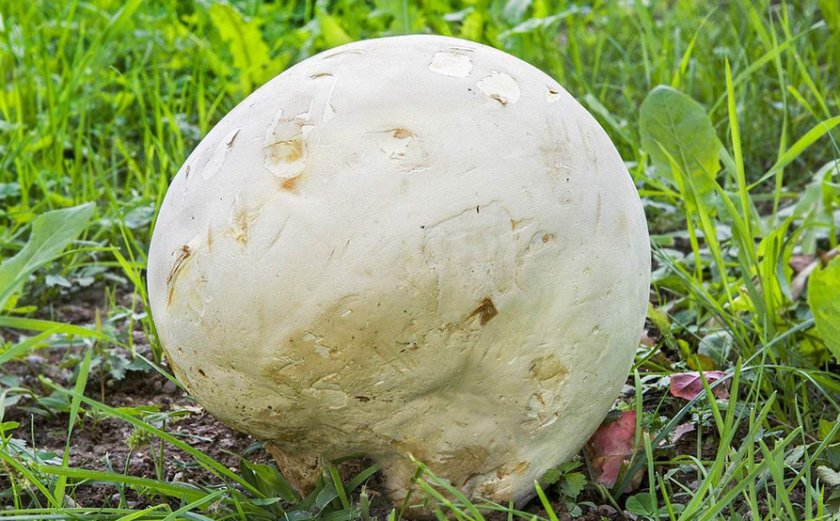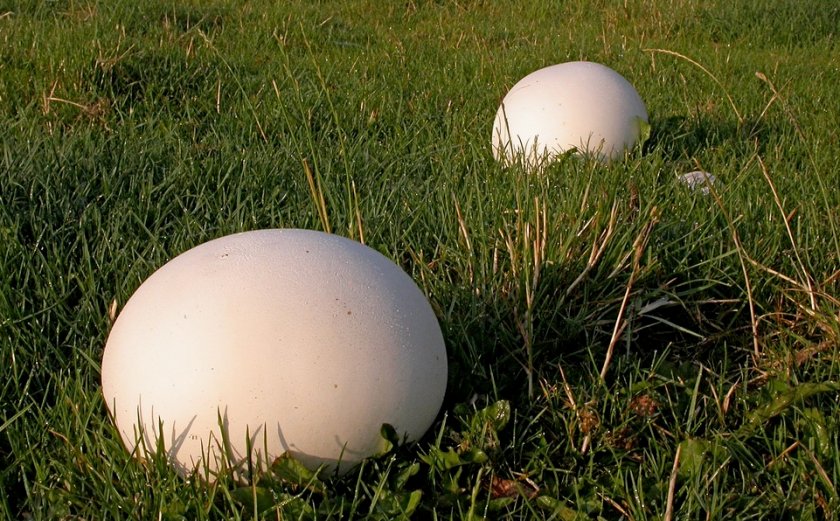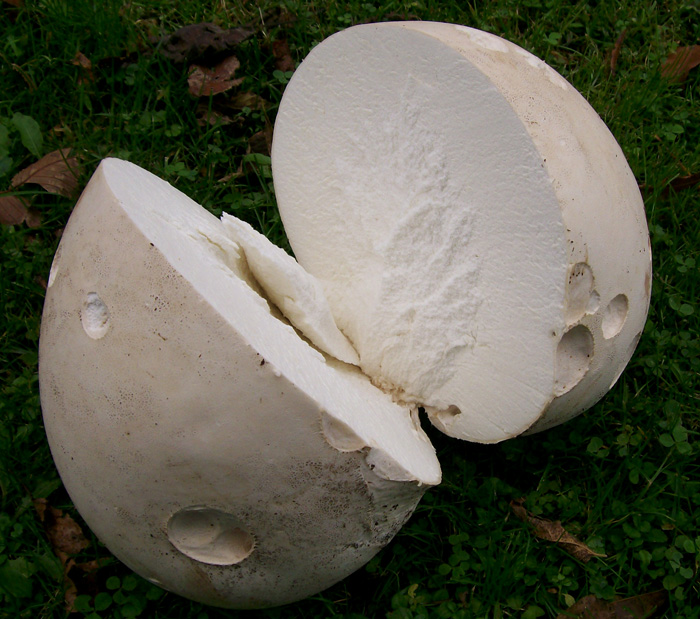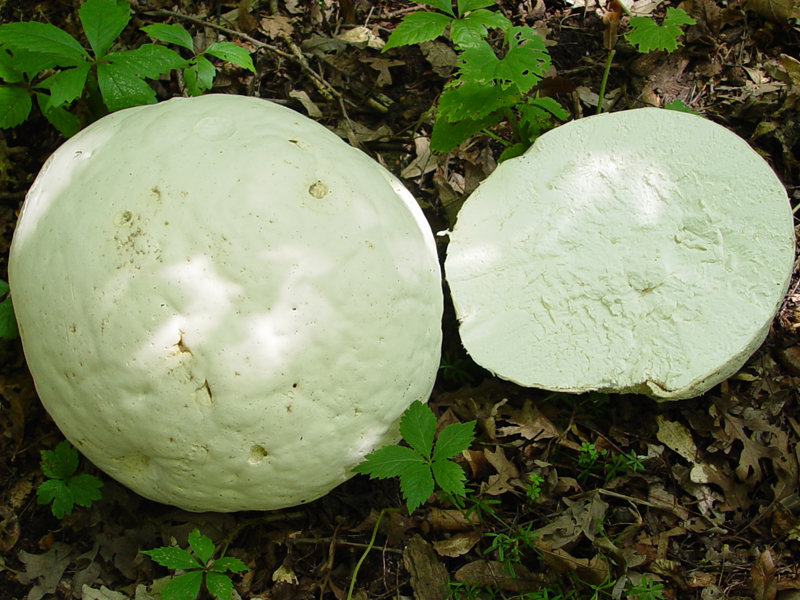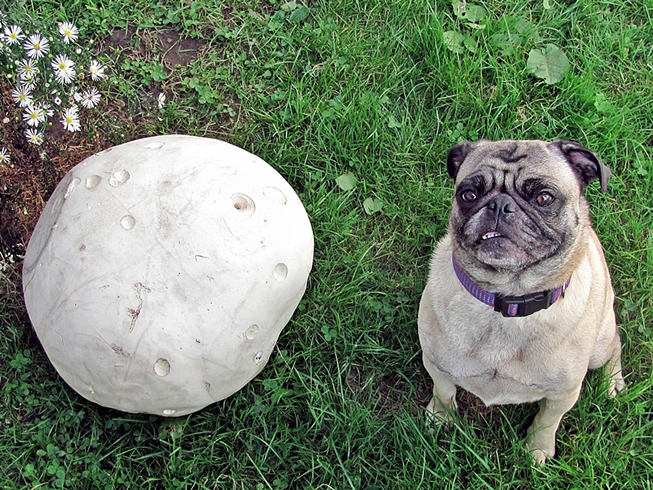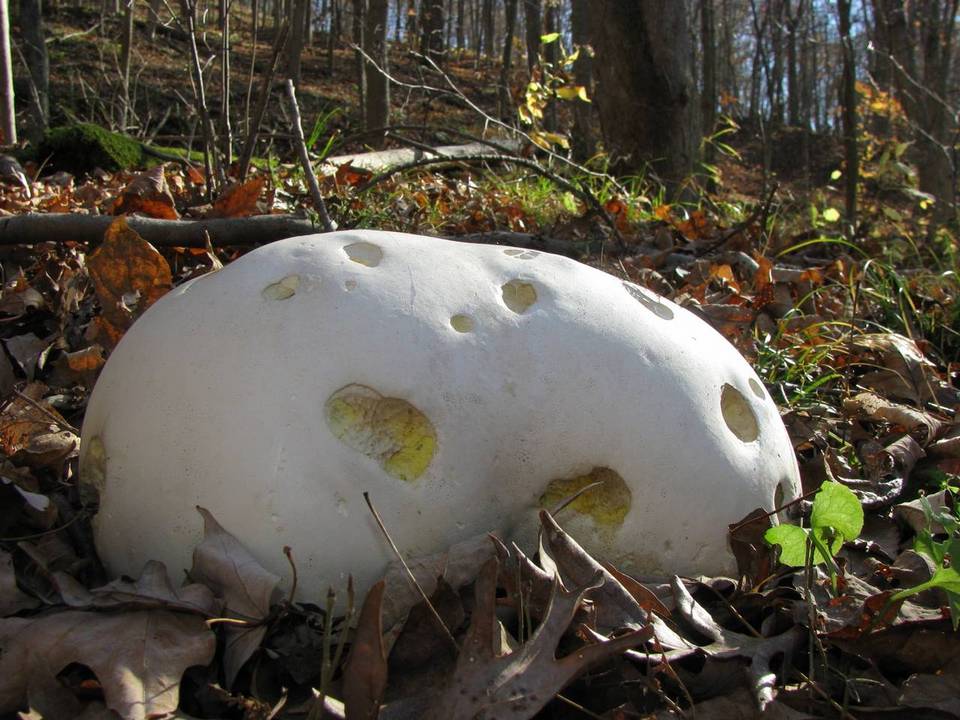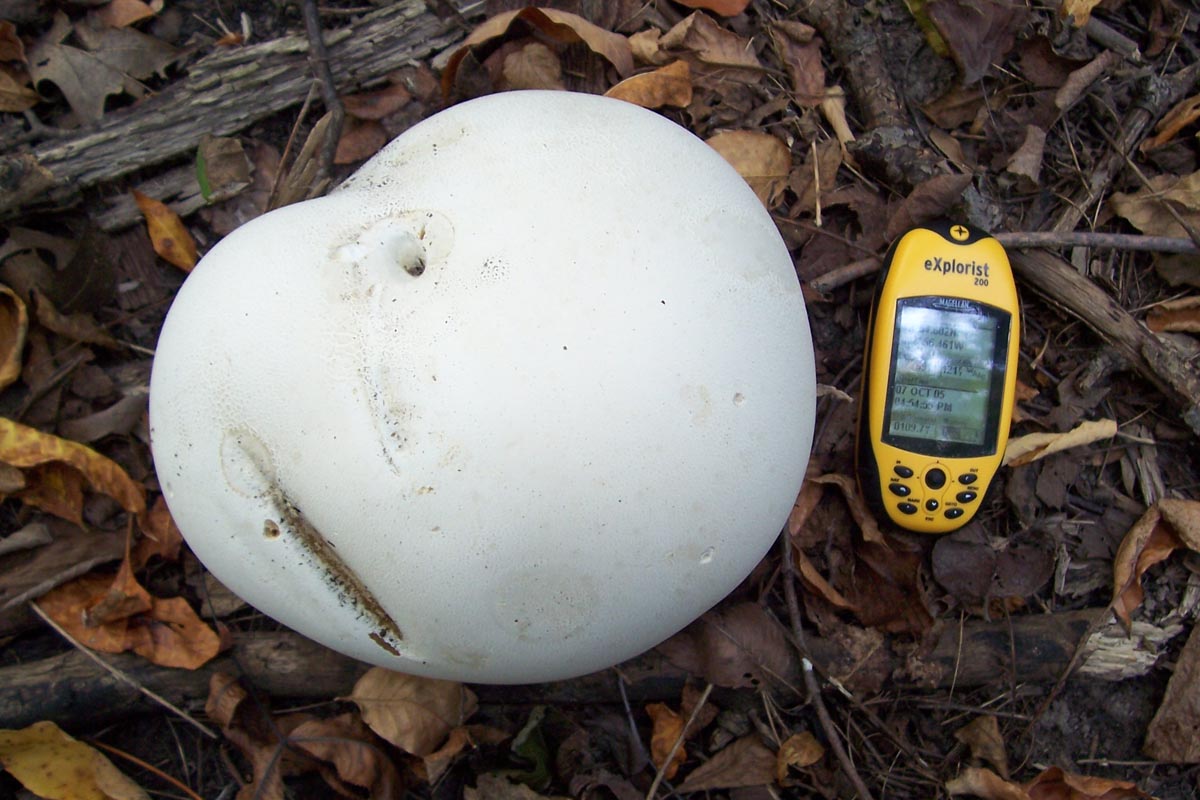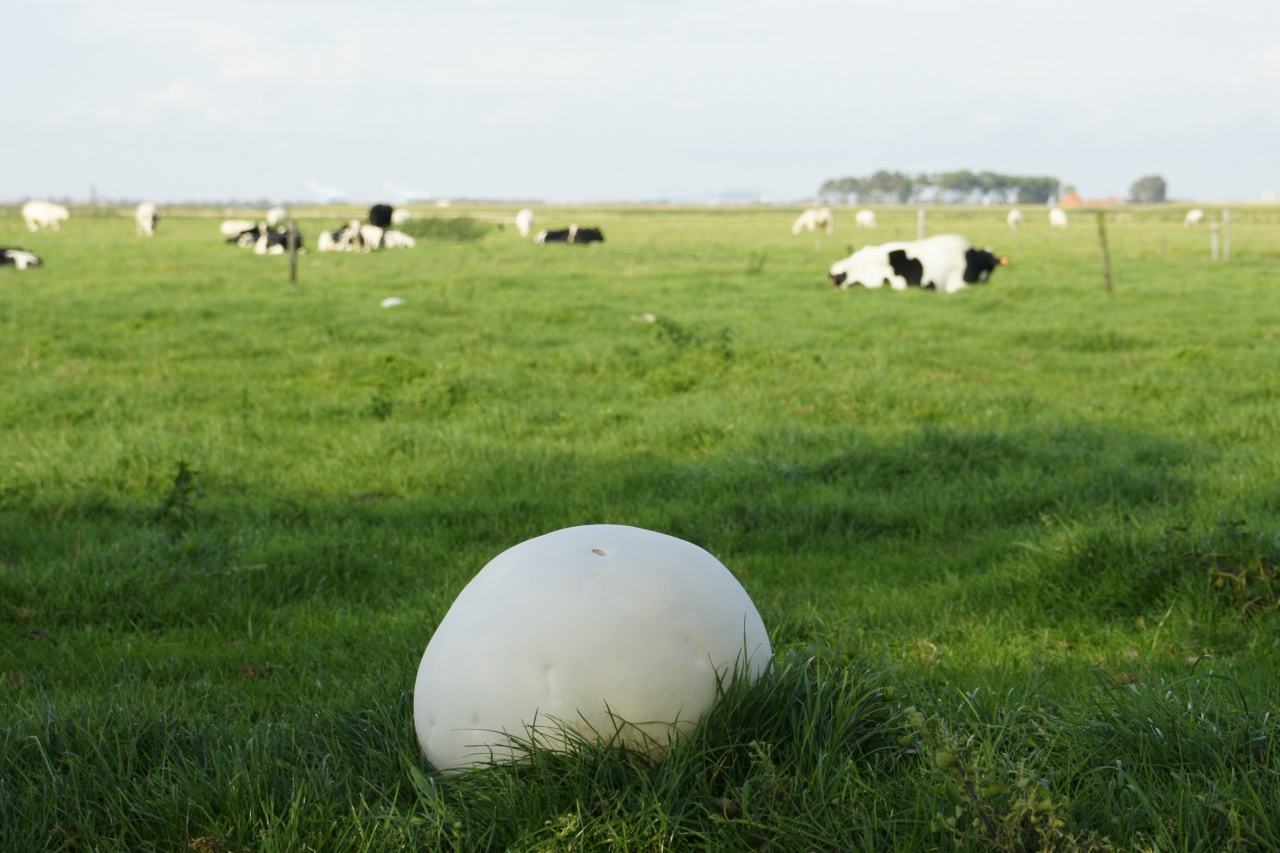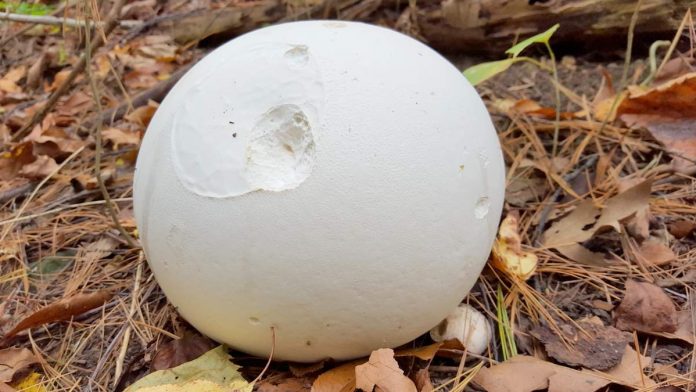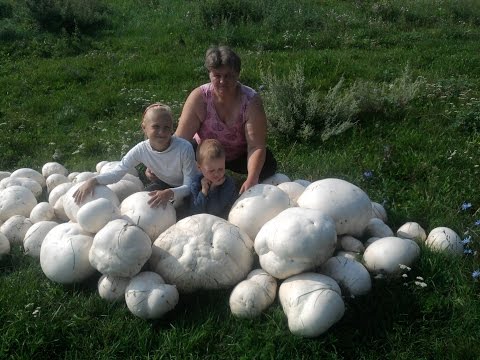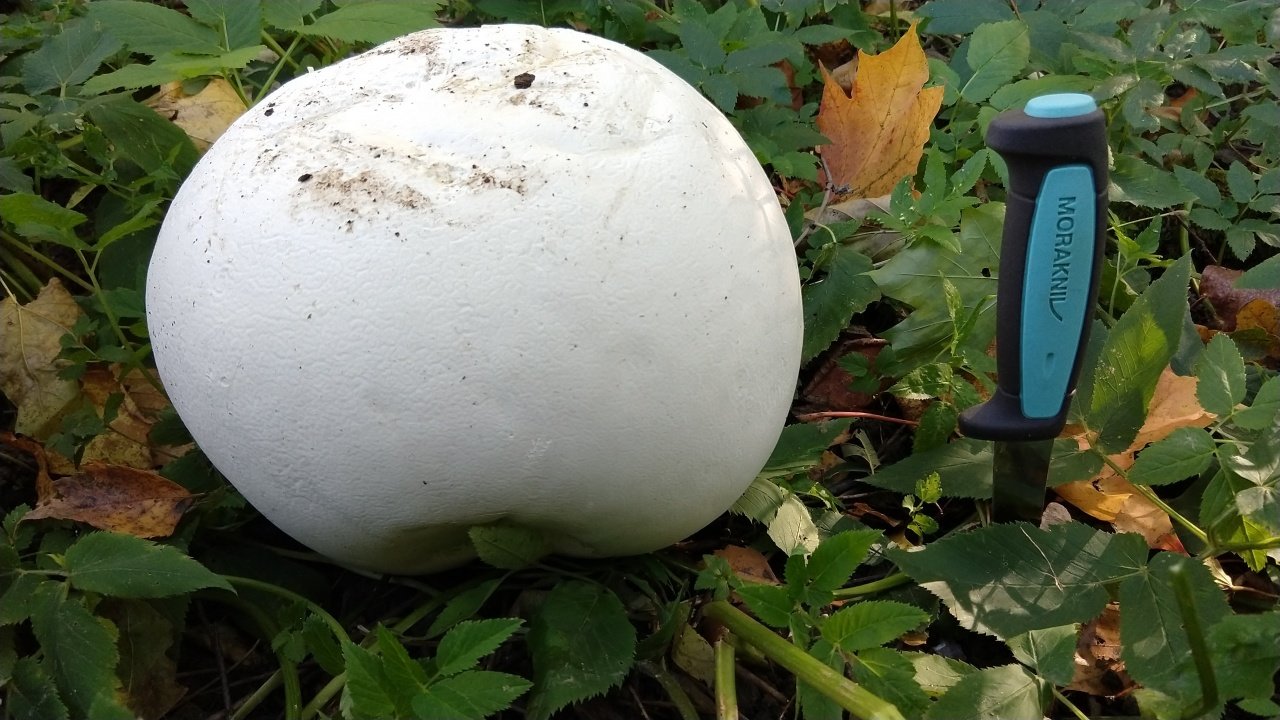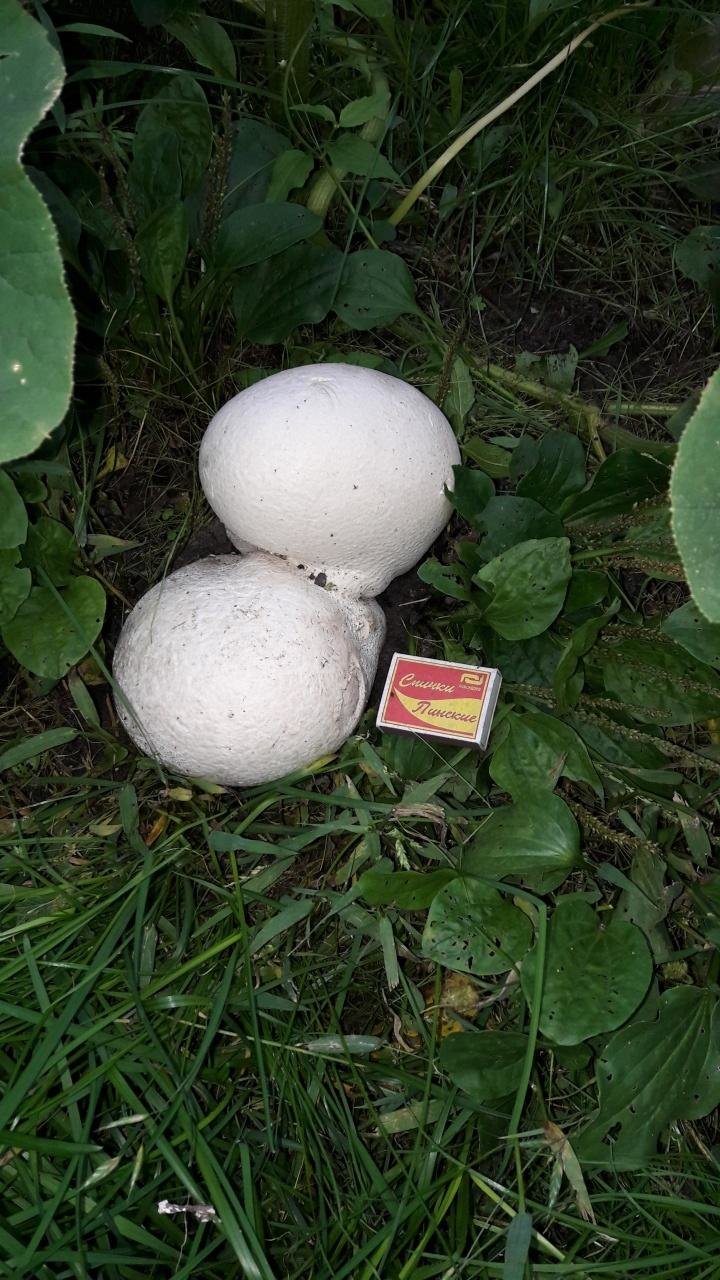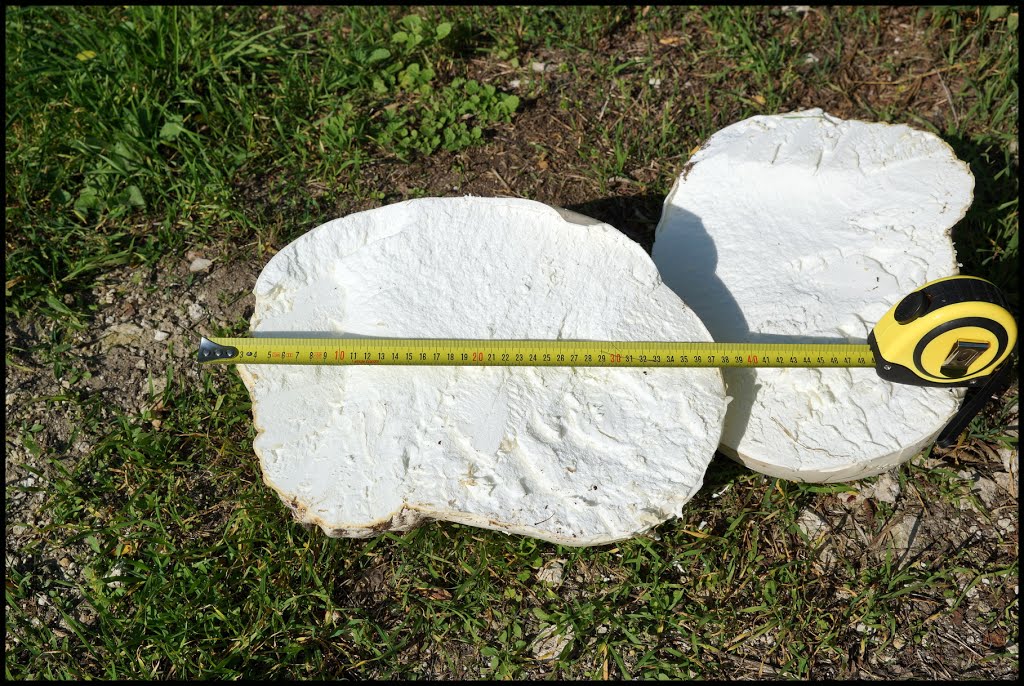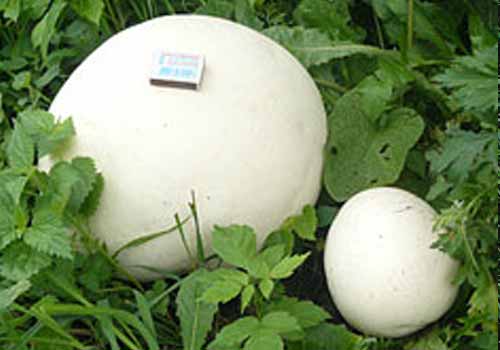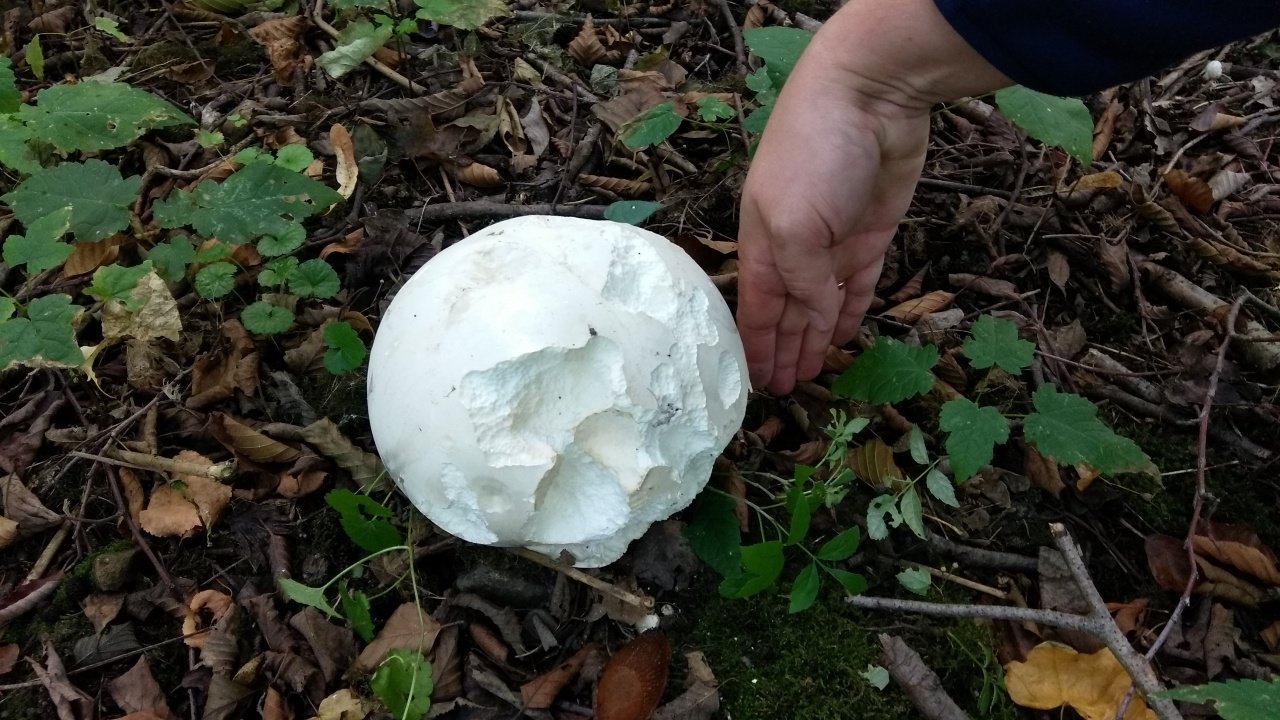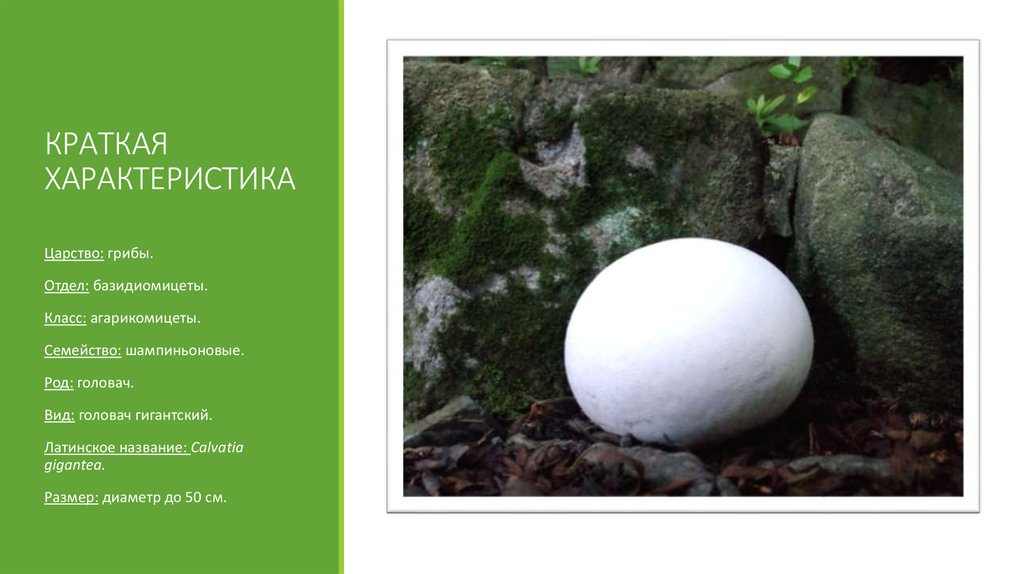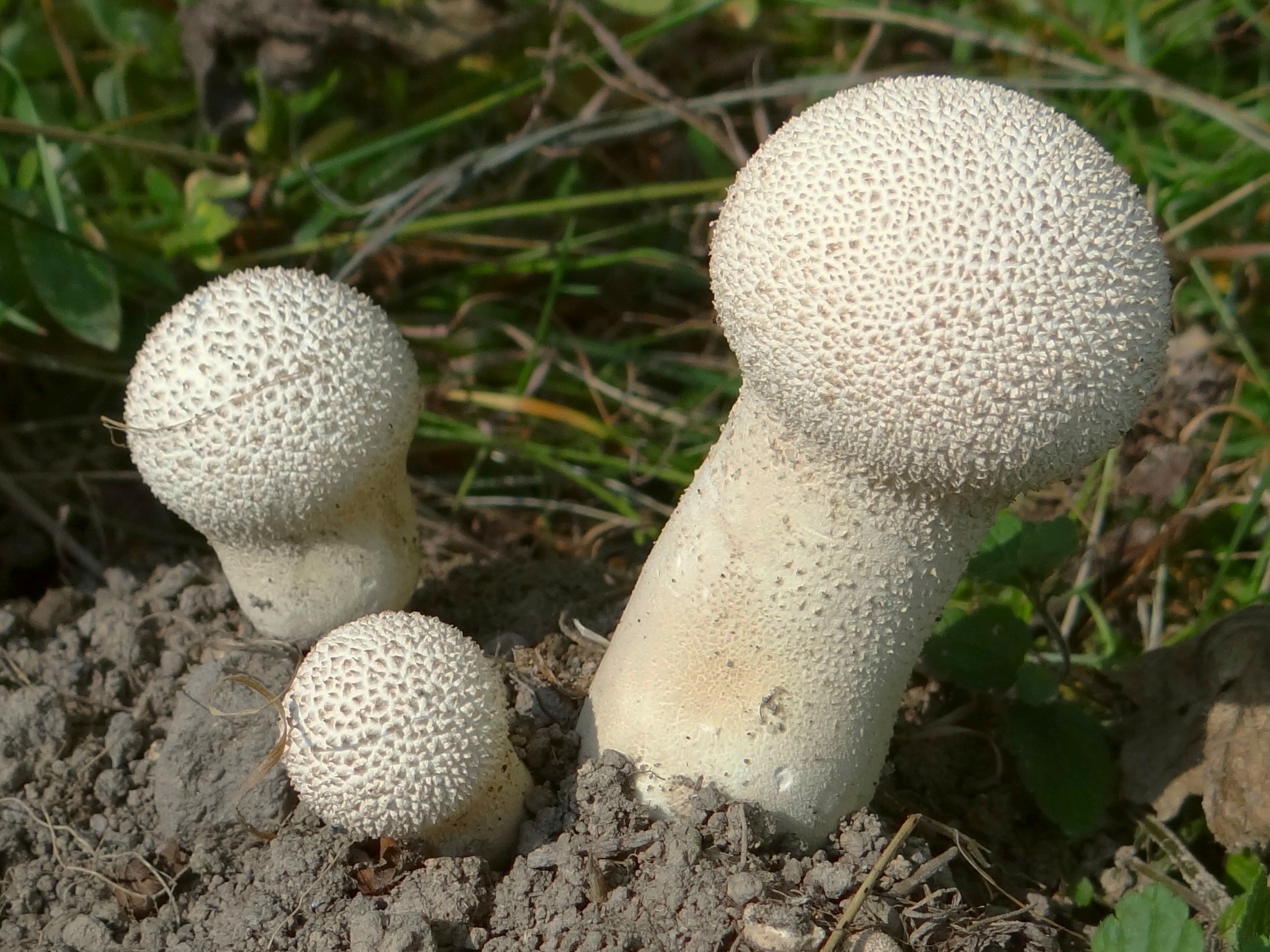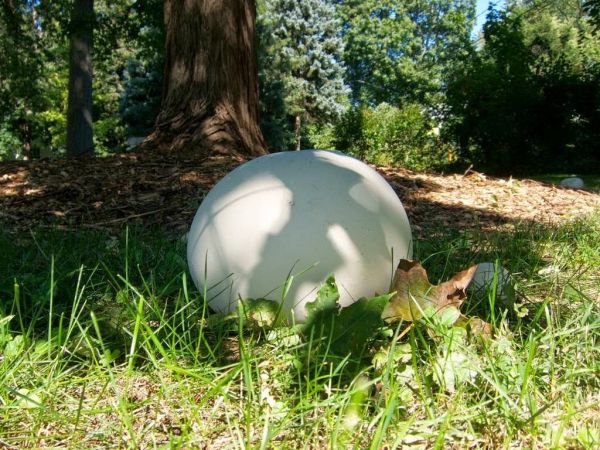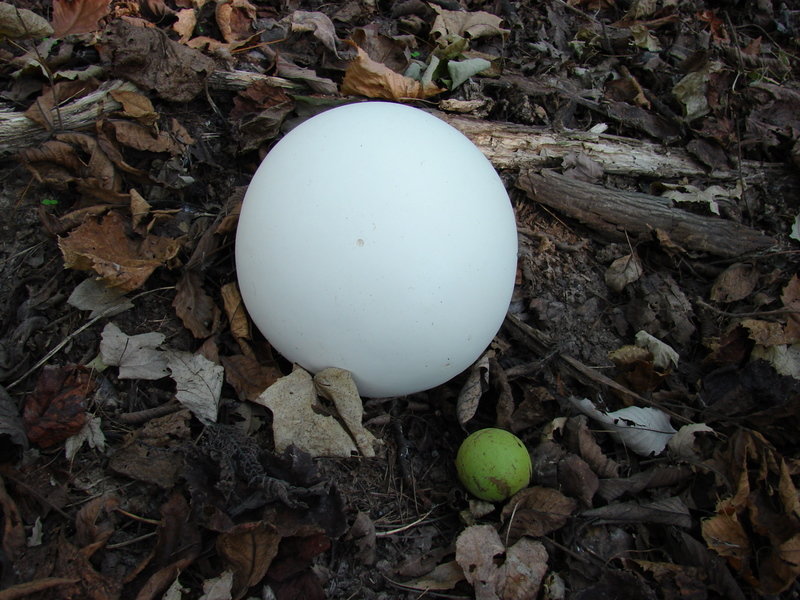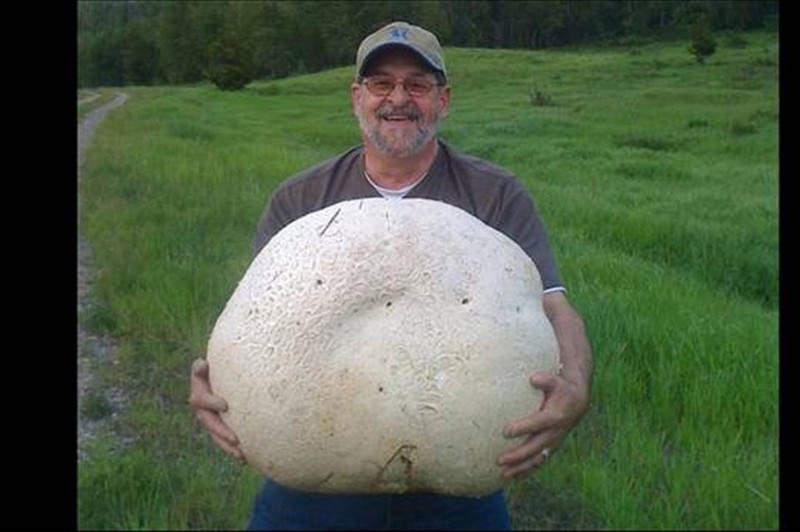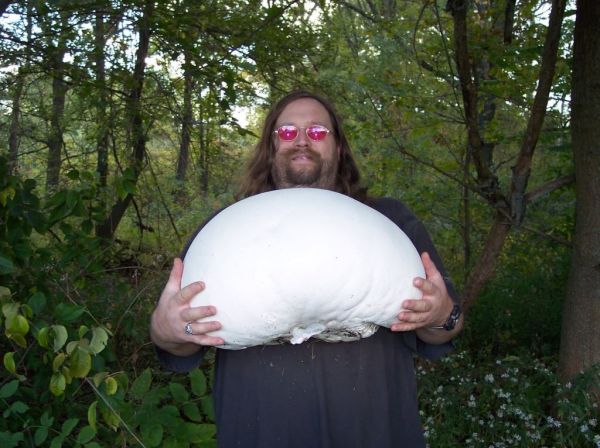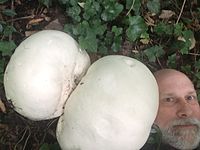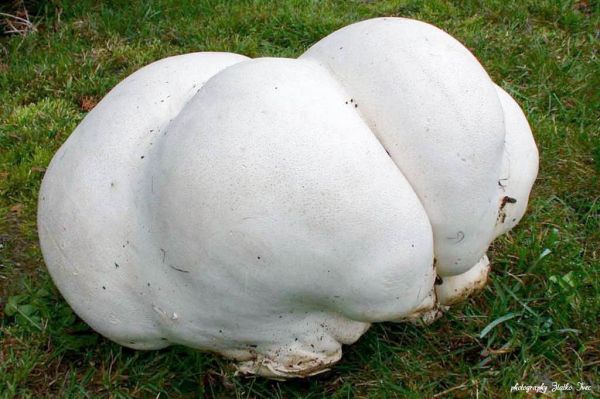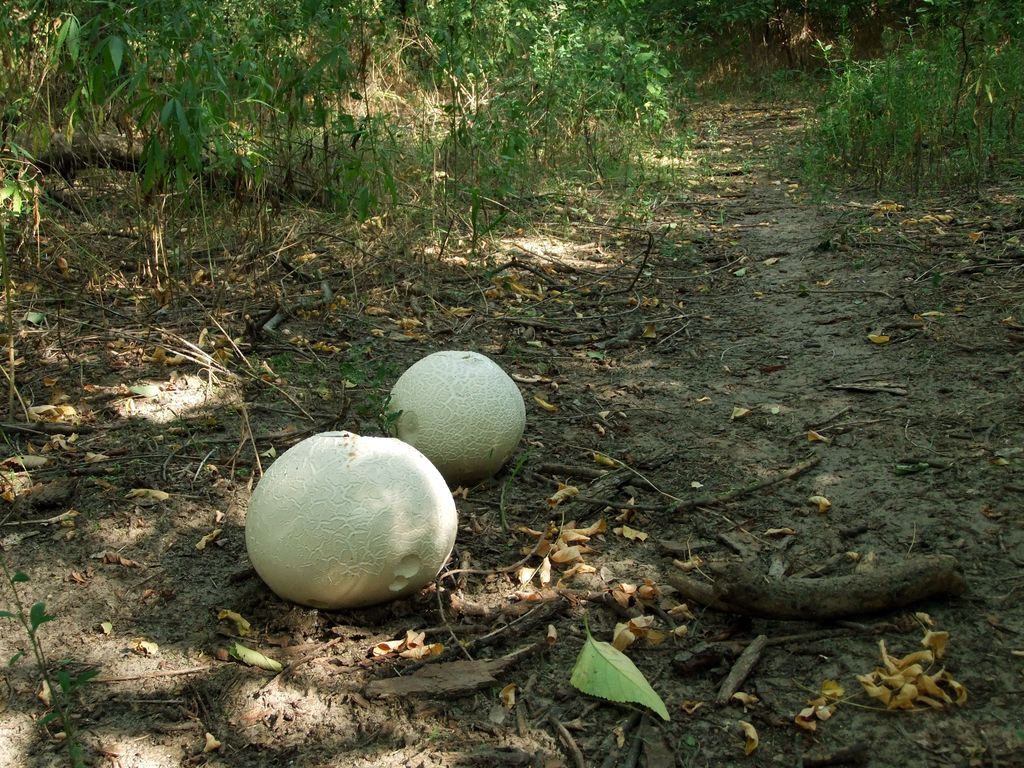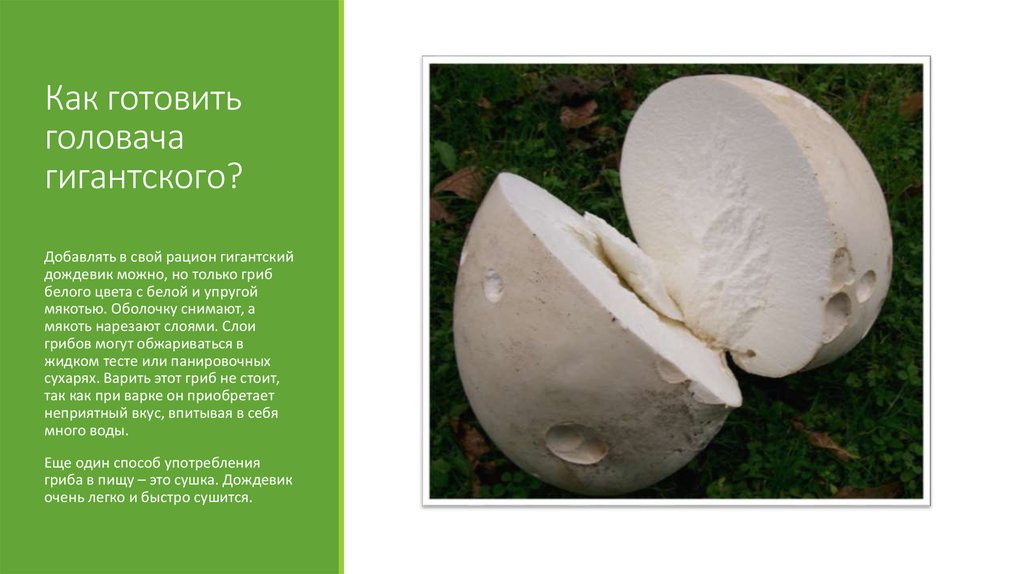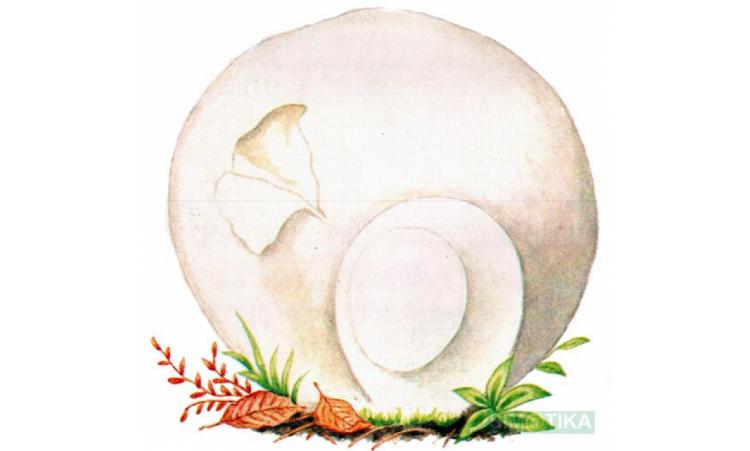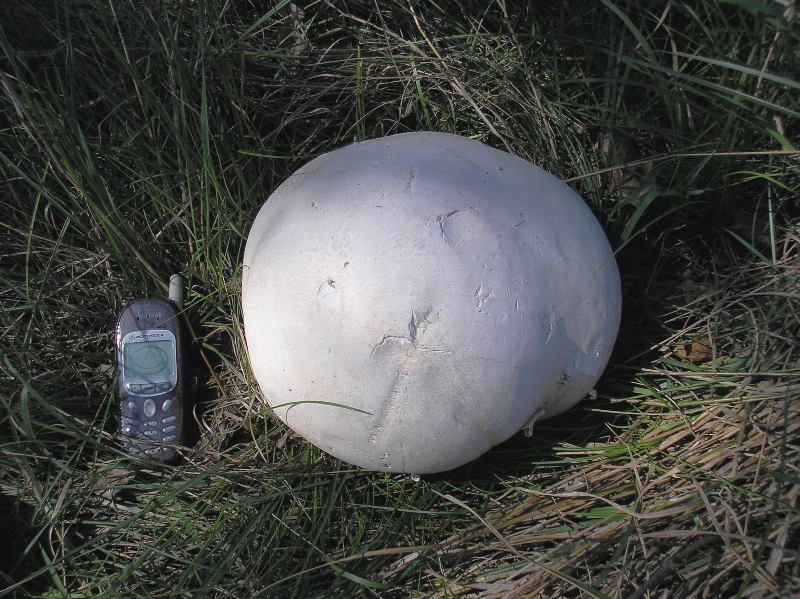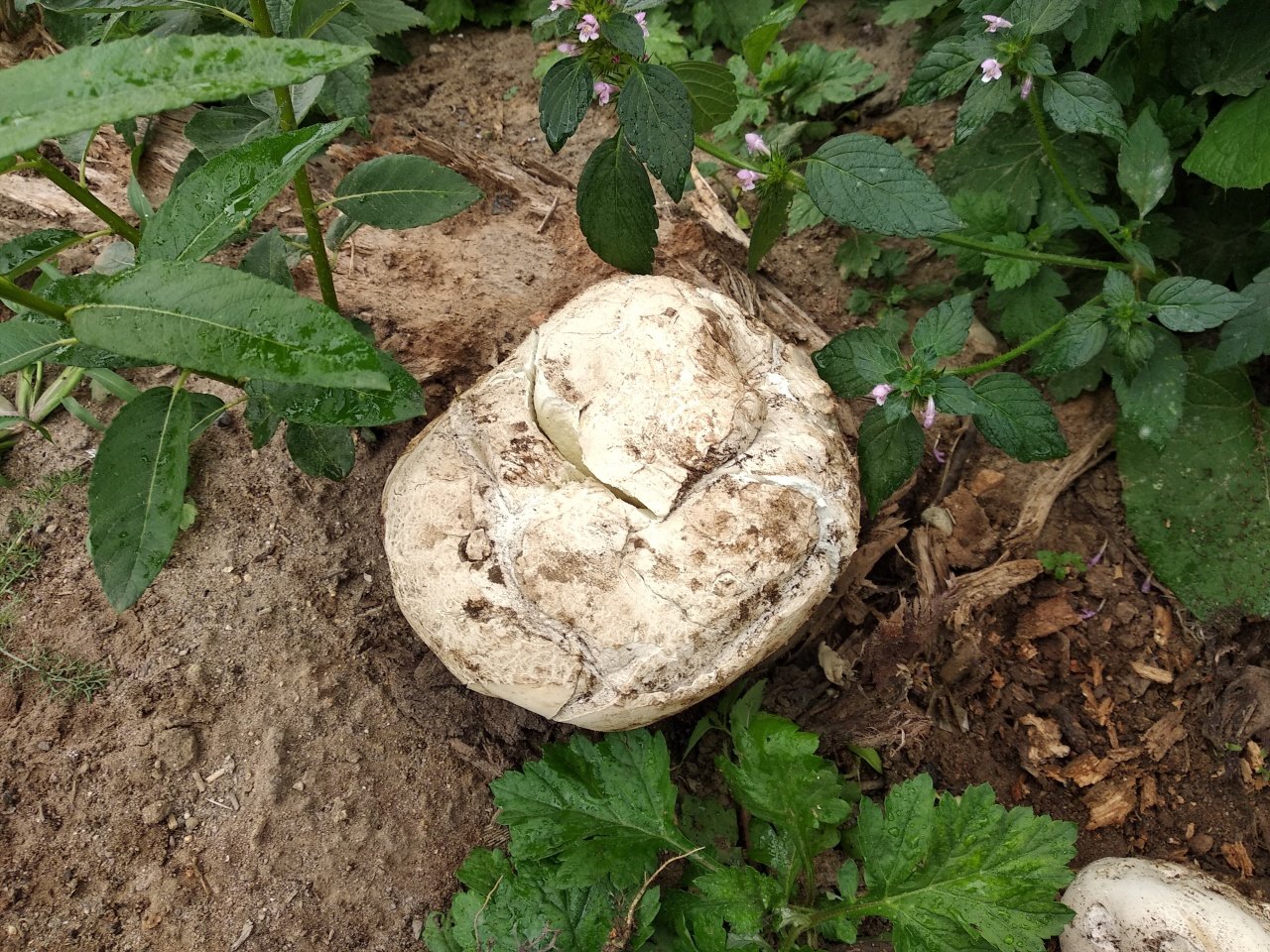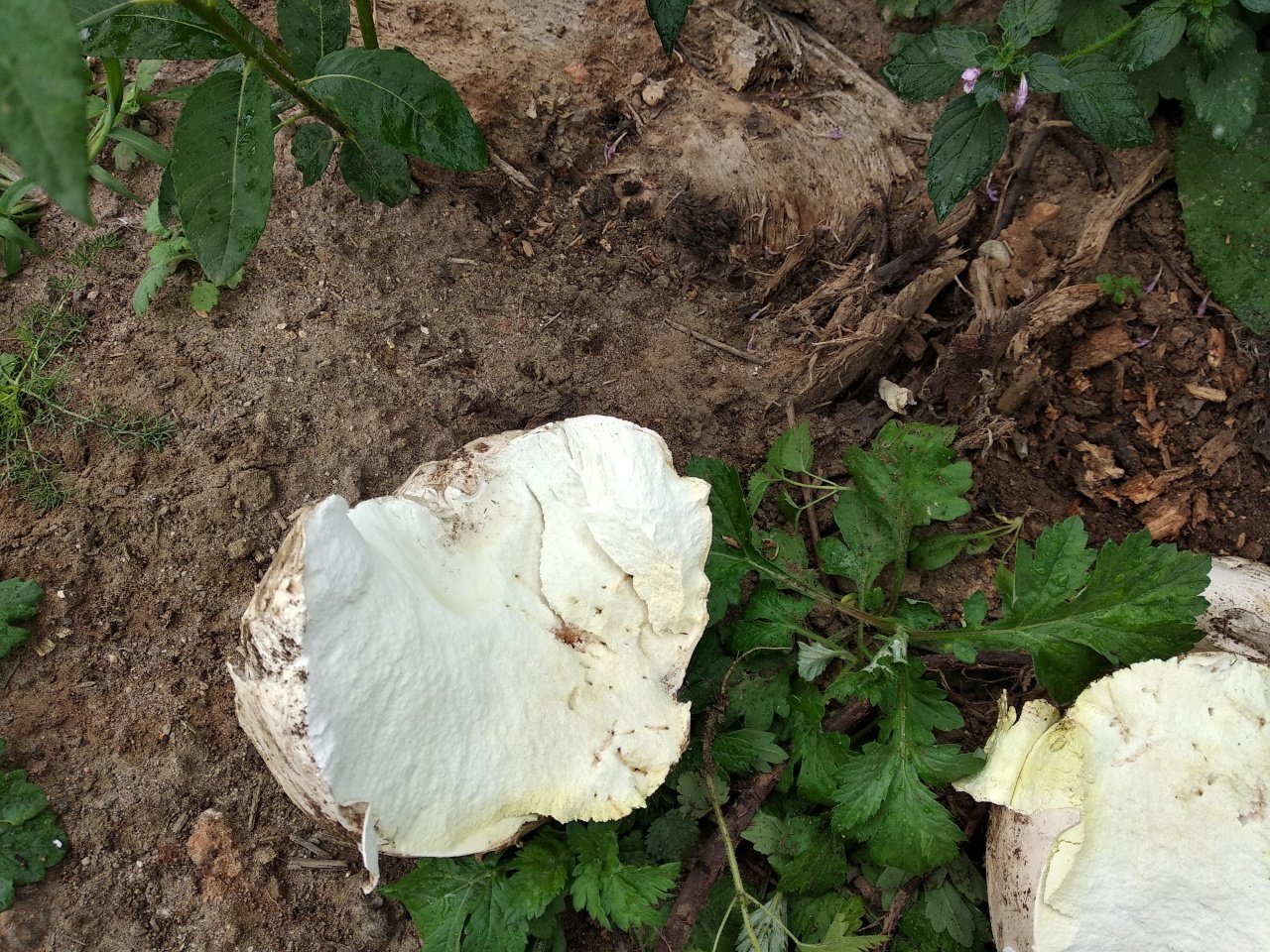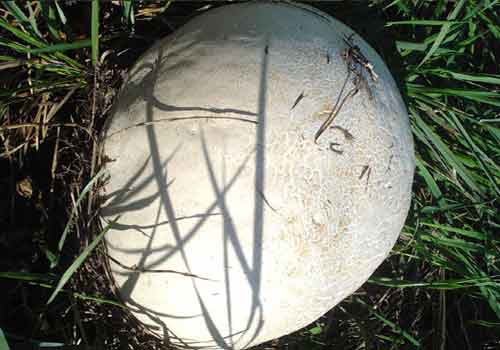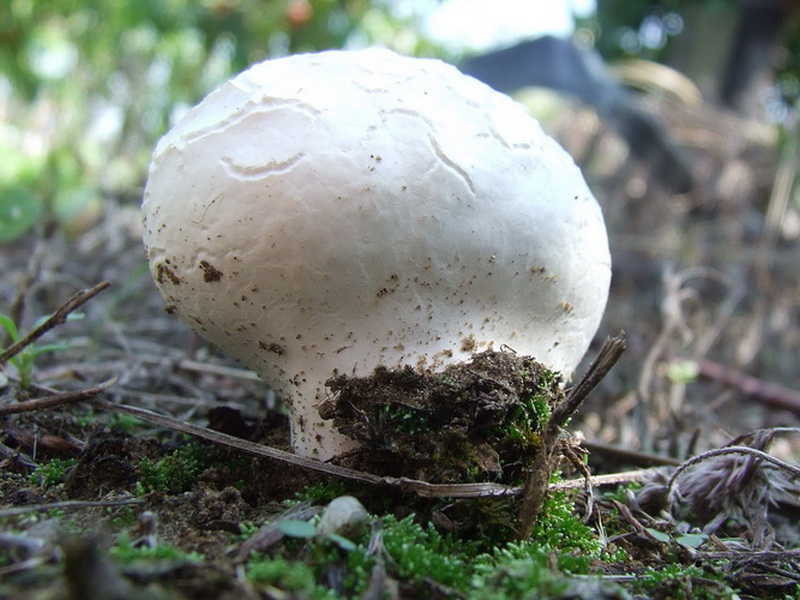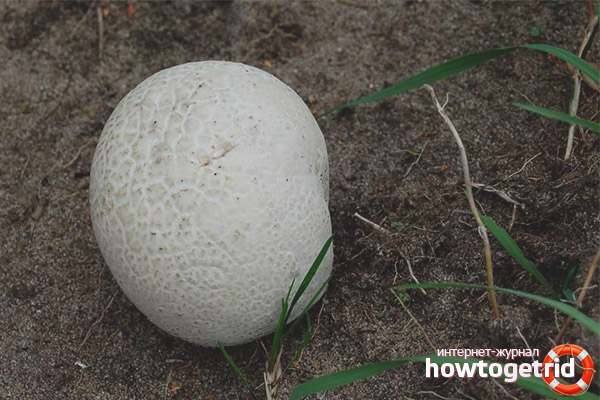Baggy golovach (round, bag-shaped): photo and description, medicinal properties
| Name: | Baggy golovach |
| Latin name: | Bovistella utriformis |
| Type of: | Edible |
| Synonyms: | Golovach is bubble-shaped, Golovach is round, Golovach is saccular, Golovach is round, Golovach is bell-shaped, Raincoat hare, Calvatia utriformis |
| Specifications: |
|
| Systematics: |
|
The baggy golovach is an edible representative of the Champignon family. The species is found infrequently, grows in single specimens at the edge of the forest, fields, meadows and pastures. Since the mushroom has similar twins, you must carefully read the description, view photos and videos.
What does a baggy bighead look like?
The fruit body reaches a diameter of 15-20 cm. The warty surface is fine-grained, painted in a whitish color, with age, the color changes to gray-brown. As it grows, the rounded fruiting body cracks and the upper part collapses. From there, the pulp falls out with spores, which scatter in the wind and give life to a new mushroom generation.
In young specimens, the flesh is snow-white, with a pleasant mushroom taste and aroma. Further, it turns brown or olive-brown and takes on an unpleasant odor.
You can recognize the view by the lumpy surface
Where and how it grows
The baggy head prefers to grow in open, sunny places. It can be found in fields and meadows, along roads, in city parks and squares. Distributed throughout Russia, bears fruit throughout the warm period.
Is the mushroom edible or not
The mushroom belongs to the 4th group of edibility. In cooking, only young specimens with white flesh are used. The mushroom is valuable among cooks, as it contains carbohydrates, a large amount of protein, micro- and macroelements, vitamins.
Before cooking, the mushrooms are washed, peeled and boiled. It can then be used to make soups, fried and stews.
Old specimens are not eaten, as they, like a sponge, absorb toxins and can harm the body.
The healing properties of baggy bigheads
Due to the rich mineral and fortified composition, the baggy bighead is widely used in medicine. One of the main medicinal properties is antibacterial action. On its basis, drugs are made against salmonella, streptococci and staphylococci.
In folk medicine, baggy bighead is used to eliminate the following ailments:
- improves vision;
- strengthens the heart muscle;
- enhances immunity;
- improves the functioning of the digestive system;
- improves the condition of teeth, bones and joints.
Despite the fact that the baggy bighead benefits the body, it also has contraindications. In large quantities, it is not recommended to use it for hypertensive patients, people with pancreatitis, peptic ulcer disease and with exacerbated gastritis.
Since the mushroom is a heavy food, it is necessary to refrain from it for children under 8 years old and not eat it 2-3 hours before bedtime.
Doubles and their differences
The baggy golovach, like any forest dweller, has similar twins. Such as:
- Blackberry-prickly puffball is an edible species that grows in small families in deciduous forests. The hemispherical fruit body is covered with closely growing thorns. The pulp is dense, whitish, with age it becomes dark brown.In cooking, only young specimens are used.
A rare species that resembles a hedgehog
The species causes poisoning when eaten.
Conclusion
Baggy golovach - belongs to the 4th group of edibility. Due to its beneficial properties, this representative of the mushroom kingdom has found wide application in cooking and folk medicine. But since the species has contraindications, it is necessary to consult a doctor before use.
How not to do
However, there are a number of contraindications. First, bypass the adult bighead. A mushroom that has managed to overripe is not suitable for food. He has accumulated in his pulp such a quantity of toxins that in terms of destructive power he can compete with all kinds of fly agarics and toadstools.
Young mushrooms are completely safe. However, even they cannot be included in the menu for children under eight years old. This limitation applies to absolutely all forest mushrooms, since the child simply does not have enough enzymes necessary to digest and assimilate mushrooms.
Otherwise, there are no taboos. Cook bighead mushrooms the way you like, eat it yourself and treat your guests.
Did you know that one of the species of this mushroom got into the Guinness Book of Records because of its enormous size? Such a bighead was found in England, and its growth reached 1.7 m in height. It is often confused with a raincoat, but these are completely different types. How it looks, as it is called by the people, and most importantly where the collection time grows, you will learn from this article.
The first question is: is the mushroom edible or not? Is it worth taking him home or is it better to walk by? Of course, Golovach or in Latin Calvatia from the mushroom family is edible, belongs to the fourth category in terms of taste.
The baggy bighead is considered the best for eating. Only young specimens can be eaten, since in adulthood the mushroom cap breaks to release the spore powder from the pulp or scientifically gleba.
Giant Golovach
The Latin name is Calvatia gigantea. Other names: Langermany.
Peculiarities:
A spherical hat, slightly flattened, can grow up to one meter in diameter and weigh up to 35 kg. At a young age, milky white, turns brown with aging and becomes unsuitable for food. The pulp resembles cottage cheese or marshmallow. It grows rapidly, so small specimens are practically not found. It is unique in its size and weight.
Where it grows:
In forests of any type, prefers acidic and nitrogen-containing soils, likes forest outskirts, meadows and pastures, found in parks. Grows singly or in a small group.
When it grows:
From August to September, after heavy rains, in the south of the country it grows to November.
Baggy golovach
The Latin name is Calvatia utriformis. Other names: round, saccular head.
Type of:
Edible, 4th category. The inside of the hat is suitable for eating. You need to collect only young specimens, while the pulp is white. Be sure to remove the skin before cooking. Suitable for frying, can be eaten raw.
Peculiarities:
The main difference: the surface of the cap has a warty structure, it grows in diameter up to 20 centimeters. Has a false stem. Young specimens are white, turn yellow over time and become brown in old age. The pulp with a pleasant smell, sterile and able to stop bleeding.
Where it grows:
In deciduous forests and mixed types, can be found on forest edges, meadows, glades and gardens. It grows mostly alone.
When it grows:
May to September.
Golovach oblong
The Latin name is Calvatia excipuliformis. Other names: elongated raincoat.
Peculiarities:
Unlike its counterparts, it has a club-shaped cap, and not a spherical one. It grows up to 15 centimeters in length and up to 5 centimeters in diameter. With age, it turns from white to brown. In youth, they have growths on the surface, old ones are smooth. Over time, the cap breaks and falls off completely.
Where it grows:
In deciduous and coniferous forests, young plantings, throughout Russia. Loves bright places, meadows and edges. It grows both singly and in groups.
When it grows:
July to October.
Application in medicine
The spores of the giant slicker are a very valuable medicine. They have high antitumor activity. A drug called calvacin is made from giant bigheads. It has shown good results in animals with cancer. Of the 24 types of tumors studied, this drug is active against 13 types.
In folk medicine, smallpox, urticaria and laryngitis are treated with the help of giant heads. This mushroom has an anesthetic effect similar to chloroform. With their help, they stop bleeding and relieve inflammation. To do this, a thin plate of mushroom pulp is applied to the affected area or its powder is used as a powder. They are used as an anti-inflammatory and hemostatic agent. For this, either thinly sliced plates of young fruiting bodies, or mature spore powder (as a powder) are used.
The bactericidal effect of the methanol extract on gram-positive and gram-negative bacteria (Bacillus subtilis, Escherichia coli, Klebsiella pneumonia, Pseudomonas aeruginosa, Salmonella typhimurium, Staphylococcus aureus, Streptococcus pyogenes and Mycobacterium and smegogmatis) was established. marxianus).
Antioxidant properties have been confirmed for the bighead. A number of studies have also established its anticancer activity. So, in the head, a substance called calvacin (antibiotic) was found, which has a pronounced oncostatic effect, inhibiting the development of leukemia and other oncological diseases. Another peptide of the bighead, similar to the protein ubiquitin, inhibits breast cancer cell culture. Biochemical studies have shown that this bighead is a natural hyperbioaccumulator of zinc and copper.
Description of the giant raincoat
The giant raincoat (Latin Calvatia gigantea, Bovista gigantea, Langermannia gigantea, Lycoperdon giganteum) originated from the Golovach genus, belongs to the Champignon family. It has several names: Giant Langermann, Bovista Gigantea, Giant Powder. Listed in Altai Red Book Territory (2006), Red Data Book of the Altai Republic (2007), Tatarstan (2009).
A raincoat, the large size of which can reach 35 cm in diameter, grows singly. The maximum weight is 10-25 kg. The structure is rather specific: it does not have a cap and legs, it is spherical.
Young mushrooms have snow-white pulp with a pleasant aroma. In the process of aging, it first turns yellow and then turns green. Such a specimen is unsuitable for food: the shell bursts, brown spores climb out.
In cooking
This mushroom is a brother of champignons, so wherever every housewife uses them, you can safely crumble a bighead or a raincoat. These mushrooms are loved for their taste, aroma and ease of preparation. However, they are not suitable for cooking soups, as the broth tastes unpleasant. Below are some delicious recipes.
Mushroom caviar
This dish is a lifesaver, it can be served on a festive table and simply spread on sandwiches, used as a filling for pies and pancakes.
Ingredients:
- Mushrooms
- Onion
- Carrot
- Eggplant or squash
- Animal fat
How to cook:
Peel all vegetables and mushrooms in equal proportions. Grind and fry in hot fat. Add salt and spices. Cool and beat with a blender until smooth.
Salad in five minutes

A really quick salad for all occasions.
Ingredients:
- Canned beans 1 can
- Mushrooms 200 gr.
- Tomato 1-2 pcs.
- Greens
- Rusks
- Turnip onion ½ head
- Salt pepper
- Mayonnaise
How to cook:
Cut greens, tomatoes and mushrooms into cubes. Mix all the ingredients, season with salt and pepper and season with mayonnaise. If you are not ready to eat fresh mushrooms, you can pre-fry them with onions.
Mushroom schnitzel

This original dish will delight even the most sophisticated gourmet. It will take about an hour of your time to cook, but the result is worth it.
Ingredients:
- Mushrooms
- Ginger
- Soy sauce
- Garlic
- Parsley
- Corn flour
- Chicken eggs
- Spices: allspice and pink pepper
How to cook:
Peel the mushrooms, cut into large round slices. Scribble the edges of each slice.
For the marinade: grate the ginger on a fine grater, pass the garlic through a press, mix everything with soy sauce and spices. Marinate the mushrooms for 15-20 minutes.
Beat two eggs. Prepare flour in a separate bowl.
For frying, heat the sunflower oil in a skillet. Dip each mushroom slice first in beaten eggs, then roll in flour and fry for two minutes on each side.
Garnish the finished schnitzels with finely chopped herbs and serve with a fresh vegetable salad.
Bon Appetit!
You might also like:
Camelina mushrooms: benefits and harms. Camelina recipes
How to pick mushrooms correctly - trim the leg or pull it out?
 Chaga - beneficial properties and uses. Chaga - contraindications and side effects
Chaga - beneficial properties and uses. Chaga - contraindications and side effects
Fans of mushroom picking know many names for this amazing representative of the mushroom family. The giant golovach is famous for its incredible size, therefore in mycology it is often known as the giant raincoat or giant langermania. Thanks to the unusual "rounded head" in the shape of a head, which has a fruiting body of the fungus, mushroom pickers often call these representatives of the plant world very consonantly - bigheads. Indeed, in nature, the shape of these mushrooms is very similar to the head. Another name for these mushrooms - "raincoat", appeared due to the fact that most often these gigantic mushrooms appear in wooded areas after long and heavy rains.
How to cook
The cooking process does not take much time. Peel and boil the potatoes. In this case, young root vegetables are ideal. Clean the raincoats, wash well and grind into slices or cubes, then fry in vegetable oil. This takes at least 25 minutes.
While the raincoats are being prepared, it is worth peeling the onions, cutting them into half rings, and then frying until golden brown in a separate pan. After that, both components should be combined in one container. Salt the mixture and fry for 15 minutes.
Finally, add sour cream to the dish. It is best to do this 5 minutes before cooking. The components should be mixed and then simmered over low heat. The dish is ready.
It should be served with boiled potatoes. You can also use parboiled crumbly rice as a side dish.Systematics:
- Department: Basidiomycota (Basidiomycetes)
- Subdivision: Agaricomycotina
- Class: Agaricomycetes (Agaricomycetes)
- Subclass: Agaricomycetidae
- Order: Agaricales (Agaric or Lamellar)
- Family: Agaricaceae (Champignon)
- Genus: Calvatia
- View: Calvatia gigantea (Golovac giant)
Other names for the mushroom:
Other names:
Giant golovach is a type of mushroom from the genus of the Champignon family.
Langermania (bighead) giant (Calvatia gigantea) - the body of the mushroom fruit has the shape of a ball or egg, flattened, sometimes up to 50 cm in diameter, at the base there is a thick tapered mycelial cord. Exoperidium is paper-like, very thin, quickly cracks into irregular pieces and disappears. The shell is thick and brittle, breaks into pieces of irregular shape and falls off, revealing a cotton-like inner pulp (gleba).
The pulp (gleba) is initially white, then yellow-green, when it is fully ripe it becomes olive brown. The color of the fruiting body outside is initially white, then gradually turns brown over time.
Spores are the most valuable medicine. They show a high antitumor effect. A medicine called calvacin was made from the mushroom, the properties of which were tested on animals with cancer and sarcoma. This drug is active against 13 types of studied tumors out of 24. It is also used in folk medicine for the treatment of smallpox, laryngitis, urticaria, has anesthetic properties similar to chloroform.
Distribution - the mushroom can be found almost everywhere, but most often in the temperate zone. It is found alone, but having appeared in one place, it may disappear at all or not appear for a very long time. This type is called "meteor". On the territory of Russia, it was found in the European part, in Karelia, in the Far East, in Siberia in the Krasnoyarsk Territory. Also in the North Caucasus. Grows in mixed and deciduous forests, meadows, fields, pastures, in the steppes one by one.
Edible - the mushroom is edible at a young age, while the flesh is firm, firm and white.
Video about the giant Golovach mushroom:
The golovach mushroom is a bright representative of the Golovach genus of the Champignon family. A fairly common mushroom in many regions of the Russian Federation. It can often be found in deciduous and mixed forests, meadows, steppes, fields, even in city parks and squares. Original appearance, size and shape, easily distinguish it from other reducers of its kind. The edible mushroom is widely used in cooking and traditional medicine.
Germinates singly or in groups. Often it has a spherical, oval, ovoid shape of the fruiting body, slightly flattened. The head mushroom grows up to 10 - 50 cm in diameter. In a young specimen, the body is white, as it matures, it darkens, cracks, acquires various dark shades of yellow or brown. The pulp or gleb at the beginning of growth is white, elastic, after ripening, cotton-like, loose, pale green or brown in color. The leg is white, thick, cylindrical in shape, it can thicken or narrow to the ground, in many species the leg is short, in others it can grow up to 15 - 20 cm. The surface of the cap of the bighead can be smooth or rough, when broken, pieces of unequal shape with torn edges are formed.
A characteristic distinctive feature is that during ripening, the fruit body almost completely cracks and falls off. The spores of the fungus are brown in color. For cooking, only young mushrooms with white, dense, elastic pulp are used.
How to cook
The cooking process does not take much time. Peel and boil the potatoes. In this case, young root vegetables are ideal. Clean the raincoats, wash well and grind into slices or cubes, then fry in vegetable oil. This takes at least 25 minutes.
While the raincoats are being prepared, it is worth peeling the onions, cutting them into half rings, and then frying until golden brown in a separate pan. After that, both components should be combined in one container. Salt the mixture and fry for 15 minutes.
Finally, add sour cream to the dish. It is best to do this 5 minutes before cooking. The components should be mixed and then simmered over low heat. The dish is ready.
It should be served with boiled potatoes. You can also use parboiled crumbly rice as a side dish.
What does a giant head look like?
The giant puffball (Calvatia gigantea) is a member of the Champignon family and belongs to the Golovach genus. This mushroom is listed in the Red Book of Tatarstan, the Altai Republic and the Altai Territory.
The mushroom got its name due to the characteristic shape of the cap, which resembles a head. Description of the distinctive features of the giant bighead:
- spherical, oval or ovoid shape of the fruiting body;
- the cap is 10-50 cm in diameter, in young mushrooms it is white and smooth, in old ones it becomes yellowish-brown in color and becomes covered with cracks, thorns and scales;
- the leg is white, often thickened or narrowed closer to the ground, has a cylindrical shape;
- the pulp is firm, white, as it ripens, it becomes loose and changes color to pale green or brown;
- spores are brown, spherical in shape with an uneven surface.

Since the flesh of the bighead is dense, it is quite heavy, some specimens weigh up to 7 kg.
How to choose the right mushroom
For many, the giant golovach seems to be an exceptionally poisonous mushroom. However, it is not. It can be eaten. The main thing is to know how to choose. Avoid collecting raincoats in wet weather. Otherwise, they will lose their appearance, turning into a gray substance. You cannot use such a product.
Only young mushrooms should be used for cooking. They do not need to be boiled and soaked in order to remove harmful components. Raincoats can be added directly to the dish while it is being prepared. In addition, young mushrooms have a denser and more elastic flesh.
Old raincoats are dangerous because they absorb a lot of toxins. It is also not recommended to pick mushrooms that grow along the roads.
Cooking applications
Golovach belongs to the fourth category of edible mushrooms. For culinary purposes, only young specimens with snow-white pulp are suitable, which, in terms of nutritional properties, are not inferior to porcini mushrooms, and even surpasses it in protein content. The chemical composition of this mushroom includes vitamins, carbohydrates, micro- and macroelements.
Eating mature mushrooms is not recommended due to the high content of toxins. For the same reason, it is forbidden to store even young bigheads for a long time, they acquire poisonous properties. Experienced chefs appreciate this mushroom for its unusual exquisite taste. After heat treatment, it resembles processed cheese or tofu. The pulp of this mushroom contains a lot of moisture, so you need to cook it in a little water.
Fried golovach
Young mushrooms are cleaned of debris, dirt and tough skin and thoroughly washed under running water. Cut into medium-sized cubes and fry in a pan for about half an hour. Mushrooms give off a lot of juice and are stewed in it. Onions are sautéed separately in vegetable oil. Mix mushrooms with onions, season with salt, add pepper and continue to fry. After five minutes, add sour cream to taste. After 5-6 minutes, the mushrooms will be ready.
Mushroom schnitzel
Products:
One kilogram of bigheads will require a liter of milk, 150 g of flour, 2 chicken eggs, 1 kg of vegetable oil, salt, spices.
Preparation:
First of all, you need to prepare the batter. To do this, mix thoroughly the egg, milk, flour and salt. The consistency of the mixture should resemble sour cream. The bigheads are cut into slices in the form of schnitzels, salted, pepper and, dipped in batter, laid out in a deep frying pan with heated vegetable oil. Schnitzel is fried until a delicious golden brown crust is formed.
Serve as a separate dish or side dish.
Bighead soup
Products:
5-6 medium-sized mushrooms, 3 potato tubers, one carrot and one onion, oil, salt, pepper.
Preparation:
Pour one and a half liters of water into a saucepan and bring to a boil. Wash, peel and cut the mushrooms into small pieces, put in a saucepan and cook for 20 minutes, periodically removing the resulting foam. To the resulting aromatic mushroom broth add finely chopped potatoes, chopped onions and carrots fried in vegetable oil, salt and spices. When the potatoes are tender, the soup is ready. When serving, herbs and sour cream are added to it.
General information about the mushroom
The fruit body of the bighead is gigantic, round in shape. Below this huge "head" is a thin leg, consisting of an interweaving of fungal hyphae. Golovach, like most other fungi, forms mycorrhiza with the roots of nearby trees. From above, the fruit body is covered with a thin white skin. Over time, it, like the snow-white pulp of a raincoat, acquires a brownish tint. Young bigheads can be eaten - their pulp looks like cotton wool, but has a characteristic taste and smell.
Connoisseurs claim that this mushroom is especially tasty when fried. Having decided to try this delicacy, it is worth remembering that it is better to eat it within 24 hours after harvesting, otherwise the mushroom will become unsuitable for food.If the raincoat found in the forest has already acquired a greenish or brown color, it is not worth collecting and preparing it. In a mature fungus, the outer shell darkens and soon bursts, thus releasing millions of brown spores.
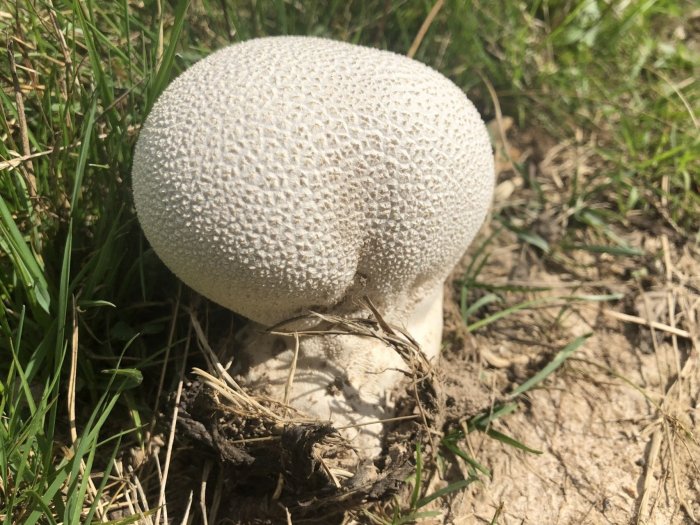 What a bighead looks like.
What a bighead looks like.
Hat
The mushroom does not have legs and caps as such; it has a spherical or ovoid fruiting body, sometimes flattened. The mushroom can grow to an impressive size - 50 cm in diameter and 20 kg in weight. The body of the giant bighead is covered with two smooth shells. The outer shell of the fungus is thin and brittle, and cracks quickly. Under it is a second, thick shell, but also prone to cracking.
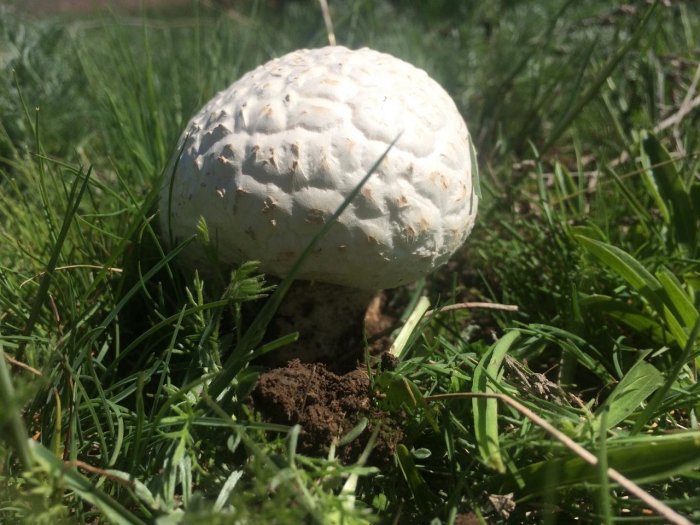 Bighead hat.
Bighead hat.
Pulp
The flesh of a young mushroom is white, then it turns greenish-yellow, and when the mushroom is fully ripe, it becomes olive brown. Also, as it matures, the surface of the giant bighead (Calvatia gigantean) turns brown. The fungus is widespread in Russia, especially in the European part, but it also grows in some areas of southern Siberia, the Far East, and Karelia.
WHO ARE GASTEROMYCETES
Giant puffballs belong to gasteromycetes, a non-systematic group of fungi with closed fruiting bodies. This group includes about a thousand species belonging to more than a hundred genera. Some gasteromycetes lead a parasitic lifestyle, while most, like the giant bighead, are saprophytes. They are able to process the dead remains of living things, turning them into inorganic compounds. Representatives of gasteromycetes are found everywhere, but the most exotic species, characterized by an unusual color and shape, are more often found in tropical countries. Golovach grows almost everywhere, but in the middle lane it can be found most often.
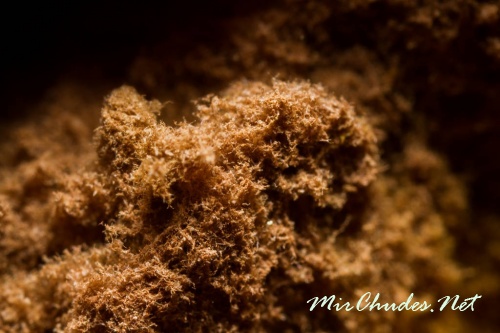
This is how the overripe fruit body of the bighead looks like: the fallen off shell exposes the loose brown mass (gleb) of the fungus.
How to grow a giant bighead (raincoat) yourself?
One giant like a raincoat can feed an entire family for dinner. To find a giant raincoat (bighead), you do not have to look for it in the forest or in the store, you can grow the mushroom yourself. Mycelium will help in this matter. Mycelium is a fungal vegetative body, consisting of hyphae - thin, branched filaments. Under natural conditions, one gram of forest litter contains up to 35 kilometers of mycelium. A shady place is chosen for future sowing. Places in raspberries, under trees, in grass or bushes are suitable. The main requirement for all these places is that the temperature at any time of the year, except for winter, should be at least 14 degrees, but not more than 29 degrees. The mushroom bears fruit every 20 days already 4 weeks after planting. When a planting site is selected, the soil must be loosened and the mycelium of the giant slicker sprinkle evenly. Then you need to cover the mycelium with a seven-centimeter layer of earth and water the planted raincoat.

The appearance of the bighead
This mushroom has many names. For example, a gigantic raincoat and a giant Langermannia. These mushrooms are called golovacs because of the peculiar shape of the fruiting body, which really resembles a head. Well, the name "raincoat" was given due to the fact that often these mushrooms appeared in the forest after heavy rains. It is not for nothing that the bighead is called giant. He is a true heavyweight champion among edible mushrooms. People who find it in the forest do not always immediately understand that they really have the fruiting body of the fungus in front of them, because most are used to collecting smaller "trophies". There is a known case when one of the lovers of quiet hunting managed to find a bighead that weighed more than 25 kg.
Giant raincoats grow not in groups, but individually. Large white "heads" can be found in deciduous and mixed forests, in fields and meadows, in ravines - where moist soils rich in nutrients lie. You can find these mushrooms from the beginning of June to the end of September.Scientists have noticed that bigheads do not grow constantly in the same area for a long time. They can disappear in this place for many years or even disappear completely. Species of fungi that grow in this way are called meteoric species by experts. Despite the fact that the giant bighead is distinguished by its truly phenomenal size, there are inedible mushrooms that can compete in size with it. So, in the 1940s, a huge polypore Oxyporus nobilissimus was discovered, weighing 140 kg and about a meter in diameter.
Evaluation of taste, medicinal properties, benefits and possible harm
The giant bighead mushroom contains the substance calvacin. In the recipes of traditional medicine, medicinal preparations are created on its basis. It helps in the treatment of kidney disease, laryngitis, urticaria, leukemia, and tumors. Present in the flu vaccine.
In medical laboratories, spores are isolated from a raincoat, and effective drugs are created on their basis. They are used for diabetes, bronchial asthma, tuberculosis, pleurisy, and women's diseases. They remove from the body toxins and heavy metals that are contained in the body of a person working or living in adverse conditions.
Refrain from eating mushrooms under the following conditions:
- fruit bodies are harvested and grown near a highway, a plant, a factory;
- if you have kidney problems;
- during pregnancy and breastfeeding;
- if there is an individual intolerance.
Features of the mushroom
The raincoat - giant bighead - has many features. Such a mushroom is very beneficial for the body. Its main feature is the absorption of radionuclides and heavy metal salts. After eating a dish made from a raincoat, harmful substances quickly leave the body in a natural way.
It should be noted that due to the named property, golovach is used for the manufacture of dietary supplements. As practice shows, such funds cleanse the body well, allow you to restore the skin and make them more elastic. If you wish, you can cook a delicious dish from the bighead at home.

Cooking giant head
A gigantic mushroom raincoat will perfectly decorate the table of any hostess and bring a touch of sophistication to the menu. The mushroom can really be called a delicacy, endowed with a special taste and aroma. Bigheads are best eaten at a young age, as long as the flesh of the mushroom is white and has an elastic, porous core. These mushrooms perfectly diversify the menu of any gourmet, because their fruits can be fried and even dried by drying. To prepare the mushroom, remove the shell, and cut the pulp itself into small layers. Pieces of mushrooms are well fried in breading, this gives them a special sophistication of taste. It is enough to dip the chopped mushroom in batter or breadcrumbs, after which it must be fried on both sides in oil.
At the same time, culinary experts do not advise experimenting and cooking the fruits of a giant bighead in water. After boiling, this mushroom absorbs a lot of moisture and tastes very unpleasant. However, this giant mushroom variety lends itself very well to drying. After that, the raincoat can very easily be used in other culinary recipes and added to different dishes.
caesar mushroom - description where it grows, the poisonousness of the mushroom
Description of the giant bighead
An inexperienced mushroom picker will bypass the bighead, not even realizing what kind of miracle is in front of him. This reaction is quite logical, since the variety does not in any way resemble mushrooms in their usual sense, having a unique structure and appearance.
The structure and features of the species
Tobacco mushroom, hare potatoes, dust collector - all these specific names belong to one representative of the Champignon family, a giant snow-white head
The fruit attracts attention not only by its shape, but also by its dimensions: the mass of some specimens reaches 10-25 kg.The diameter of this giant head is appropriate, often reaching half a meter, although there are also very small fruits up to 10 cm

The surface of the fungus is also heterogeneous: smooth and velvety at a young age and rough with numerous cracks and spots towards the end of its life cycle. Depending on the state of the mushroom shell, its shade can also change, which, as it grows, often loses its original whiteness, leaving in a yellowish or even brownish-brown tone.
Curious! The flesh of this amazing fruit is also of interest, it is as white and elastic as its surface, which turns into a loose pale green, and sometimes even brown mass by old age.
As for the mushroom leg, the variety practically does not have this part, so it is not at all surprising that after full maturation and aging, the bighead falls to one side, opening its numerous dark brown spores for reproduction to the external environment, which are carried by the wind. Sometimes the base of the fruiting body is more pronounced, making this miracle mushroom look like a giant blank.
Is the mushroom edible or not
The dust collector did not receive one of its names by accident, because during many years of research it was proved that the fungus tends to accumulate toxic substances in itself even more than other species.
And although we are not talking about the threat of serious poisoning, since the tobacco fungus is not poisonous, the risk of getting even a slight intoxication excludes the consumption of mature and even more old specimens. For the same reason, long-term storage of the harvested crop is not recommended, which should be heat treated as soon as possible.

But young fruits with their white dense pulp are very good, having received a fairly wide culinary use. It is worth noting the high nutritional value of the product, which is as close as possible to the gourmet porcini mushroom. The taste of the bigheads is exquisite, somewhat reminiscent of the delicate soy cheese tofu, and is especially appreciated by true gourmets who use this variety for frying and making transparent rich stews.
In this case, it is better to abandon the preliminary boiling of fruits, the moisture content of which is already excessive. That is, you can use the mushroom right away, without resorting to prolonged soaking or cooking, since young fruits are not at all dangerous.
Growing environment of the giant head
Bighead mushrooms got their nickname for a reason, because they are the undisputed heavyweight champions in the kingdom of edible mushrooms. At the first meeting in the forest, mushroom pickers will not immediately understand that a real fruit body of a giant bighead is growing in front of them. Giant raincoats cannot be found in the same area several times, they can appear in a specific area and then disappear for a long period. Scientists call the varieties of such "nomadic mushrooms" meteoric mushrooms.

Bigheads can be called solitary mushrooms, since, unlike their relatives, they do not grow in groups. The giant slicker grows best in soil rich in moisture, nitrogen and other nutrients. That is why bigheads can often be found in places with high humidity. As a rule, they grow on the edges of mixed and deciduous forests, in damp lowlands of meadows and fields, humid ravines and steppes. Mushrooms grow after heavy rains and can be found from the onset of June to early October.
lattice red - description, where it grows, the poisonousness of the mushroom

